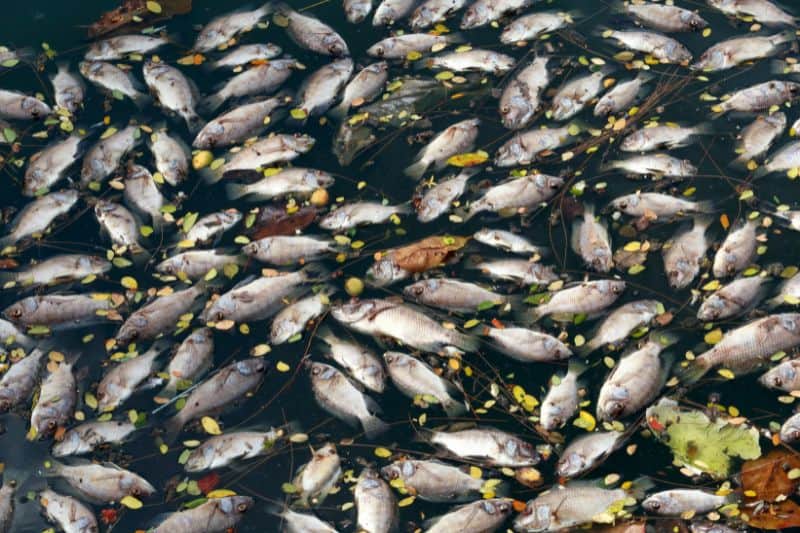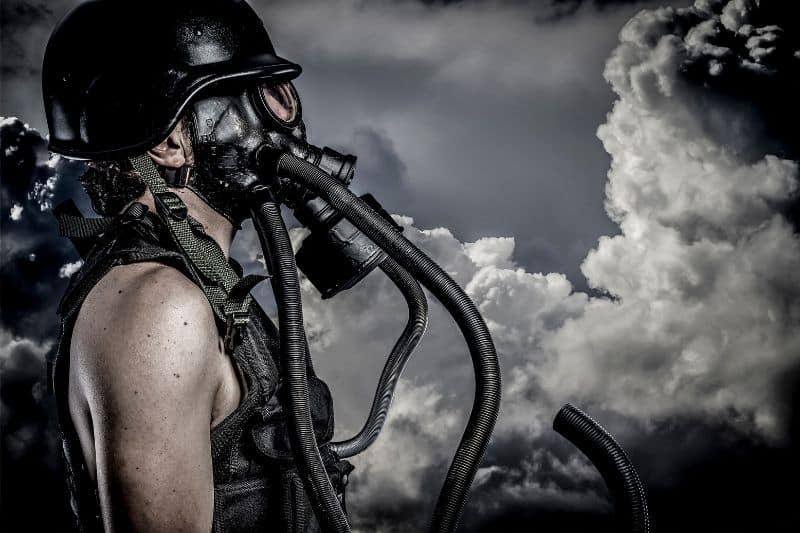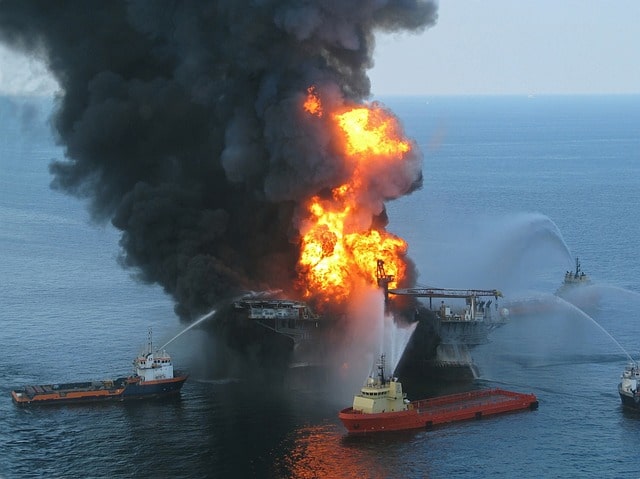On various occasions in history, the planet has been compelled to shoulder some of the worst environmental disasters caused by human activities.
These disasters range from wars to nuclear explosions, chemical spills, toxic gas leaks, and oil spills.
Whenever these disasters occur, the environmental consequences presented are very high, and their impacts are felt for hundreds of years.
In some cases, property and lives remain damaged beyond repair or full compensation.
According to Wikipedia,
“An environmental disaster is a disaster to the natural environment due to human activity, which distinguishes it from the concept of a natural disaster. It is also distinct from intentional acts of war such as nuclear bombings.“
This article gives an account of the top 15 worst human-induced environmental disasters in history.

1. The London’s Killer Fog
At the heart of the Industrial Revolution, London was one of the nations influencing the industrialization market. On this account, there was a lot of energy utilization, especially the use of coal.
This often released pollutants in the air that made the people used to seeing foggy and heavily polluted air.
However, in 1952, this pollution became disastrous. During that winter, the weather was so cold, and residents burned more coal than usual to relieve the cold.
As a result, the smoke, together with nitrogen oxides, soot, and sulfur dioxide, reached high levels and covered the entire London in a black cloud of almost complete darkness, a phenomenon that killed over 12,000 people.
2. The Nuclear Power Plant Explosion in Chernobyl, Ukraine
On April 26, 1986, a reactor shutdown was experienced at the Chernobyl Nuclear Facility.
A run-away nuclear reaction resulted in a horrific fire and explosion, claiming the lives of 50 personnel instantly and expelling more than 400 times the radiation released during the Hiroshima atomic bomb.
More than 4000 cancer deaths have been linked to the extensive spread of radioactive substances.
Belarus was heavily affected, and radioactive contamination was detected as far as the British Isles. Radiation levels at the site are still high, and the amount of nuclear materials buried under the debris remains unknown.
3. Union Carbide Cyanide Gas Leak, Bhopal, India
In December 3, 1984, Union Carbide India Limited pesticide plant in Bhopal, Madhya Pradesh, India, accidentally released a deadly chemical fog, which killed more than 5,000 people.
They were victims of fatal poisoning by an isocyanate (pesticide) gas. More than 50,000 people went through treatment due to exposure to the gas, and more than 500,000 people were exposed to the gas.
Proponents claim the gas leak has claimed an additional 20,000 lives since. It is regarded as the worst industrial chemical disaster ever.
4. The Exxon Valdez Oil Spill
On March 24, 1989, 260,000 to 750,000 barrels of crude oil were spilled in Prince William Sounds, Alaska, by the oil tanker Exxon Valdez. It came from an accident after the oil tanker crashed into Bligh Reef.
Research categorizes it as one of the most destructive human-caused environmental disasters with both long-term and short-term effects.
The instant outcome was the deaths of 100,000 to as many as 250,000 seabirds, at least 2,800 sea otters, 300 harbor seals, 247 Bald Eagles, 22 Orcas, and an unidentified number of salmon and herring.

5. The Seveso Disaster
In July 1976, an explosion at a chemical manufacturing plant north of Milan, Italy, released Tetrachlorodibenzo-p-dioxin (TCDD) into the atmosphere. The gas severely affected the neighboring town of Seveso.
Shortly after, 3,300 animals died, and many more were eliminated to stop the spread of the contamination into the food chain. About 500 people were found to have skin lesions, and children were hospitalized with skin inflammation.
6. Minamata Disease Disaster
In 1956, Chisso Corporation’s industrial wastewater containing methylmercury was released into Minamata Bay and the Shiranui Sea.
The outcome was one of the most damaging pollution diseases in the history of Japan — Minamata.
The disease was caused by severe mercury poisoning that attacks the nervous system. About 2,250 people succumbed as a direct outcome of the pollution event.
7. Southern Leyte Rock-slide/Avalanche, S. Leyte Province, Philippines
In February 2006, an enormous avalanche of rock, soil and debris poured into a populated valley of Southern Leyte Province in the Philippines after a week’s long heavy rain and minor earthquake.
The instant outcome was the burying of the mountain village of Guinsaugon in the town of Saint Bernard.
The incident killed thousands of people, including 250 children who were attending elementary school at the time. More than 1500 persons are still missing to this day.
The disaster is said to be an outcome of nonstop logging and unregulated mining around and within the mountainside forest surrounding the valley.
8. British Petroleum Oil Spill, Gulf of Mexico
In April 20, 2010, there was an explosion and sinking of a deepwater horizon oil rig in the Gulf of Mexico. The oil rig was leased and controlled by BP (British Petroleum) and was regarded as the most prominent accidental marine oil spill in the petroleum industry’s history.
Eleven employees died as a result of the explosion. The explosion also released about 60 million barrels of mixed-grade oil from the disconnected well, which went on for more than four months.
Over 34,000 birds (including egrets and blue heron), hundreds of sea turtles, about 72 dolphins, and other marine vertebrates and invertebrates were poisoned, suffocated and died in the floating oil.
9. Amoco Cadiz
In March 16, 1978, a substantial crude oil tanker, Amoco Cadiz, ran aground on Porstsall Rocks, and as a result, it split into three and sank.
It spewed out 1,604,500 barrels (219,797 tons) of light crude oil and 4,000 tons of fuel oil, altogether resulting in the biggest oil spill of its kind at that occasion and in history.
The spill contributed to the most significant loss of marine life ever registered from an oil spill. Millions of dead sea urchins, molluscs, and other bottom-dwelling organisms washed ashore two weeks after the event, and the death of most animals continued for over a period of two months.
Diving birds were the majority of the dead animals, as about 20,000 dead birds were recovered. Dead oysters were approximated at 9,000 tons.
10. Baia Mare Cyanide Spill
In January 30, 2000, one of the worst environmental disasters in Europe was experienced. The disaster was a result of a cyanide spill in Baia Mare, Romania.
100,000 cubic meters of cyanide-contaminated waste leaked out from a dam, sending 100 tons of cyanide in large quantities into the Somes, Tisza, and Danube rivers.
There was an enormous loss of aquatic life. An abundant amount of aquatic plants and fish died, and up to about 100 people were admitted to hospitals for poisoning-related cases after consuming contaminated fish.
Tests found cyanide levels between 300 and 700 times beyond pollution standards.
11. TVA Kingston Fossil Plant Coal Fly Ash Slurry Spill
In December 22-24, 2008, the largest spill of coal ash took place at the Fossil Plant, a coal-powered generating plant owned by the Tennessee Valley Authority (TVA).
The plant held 1.1 billion gallons of coal fly ash slurry, and when the disaster happened due to an accidental rupture, it sent out a six-foot thick, 300 million gallon wave of ‘fly ash’ sludge into the river and along its banks.
Even though there were no reported fatalities or injuries, it damaged several properties and government facilities. Neighboring residents had to be relocated on Christmas Eve, and there were reports of large fish kills downstream.
12. Jilin Chemical Plant Explosions
In November 13, 2005, there was a series of explosions at the Jilin Chemical plant – Petrochemical plant in Jilin City, Jilin Province, China.
These explosions claimed the lives of six employees and left numerous people injured, creating the need for evacuating tens of thousands of neighboring residents.
What’s more, the explosions adversely polluted the Songhua River with approximately 100 tons of pollutants containing nitrobenzene and benzene, whose exposure diminish white blood cell count and is linked to leukemia.
13. Love Canal, Niagara Falls, New York
In 1953, a local company dumped 21,000 tons of toxic industrial waste into the abandoned Love Canal.
Over the next few years, housing development and schools were built atop the canal zone, and waste began to bubble up into backyards and cellars.
By 1978, the problem was unavoidable, and hundreds of families were relocated and compensated. The Love Canal disaster led to the foundation of the “Superfund” act, which helps pay for the cleanup of toxic sites.

14. Gulf of Mexico Dead Zone
This is one of the ill-famed aquatic regions that arose due to human activity. It is considered the largest “dead zone” region in the United States.
Hundreds of fish are often found floating dead in the Gulf of Mexico Dead Zone. The cause for the “dead zone” is the relentless dumping of phosphorus and nitrogen nutrients in the area.
The nutrients come from the Mississippi River, which is the drainage area for nearly half of the nitrogen and phosphorus waste, among other nutrients of continental America. Aquatic species, including plants and fish, cannot survive in the area completely.
15. E-waste in Guiyu, China
Guiyu, China, is considered to be the area with the biggest electronic waste site on the planet. The dumping of obsolete electronics in the area is extensive, which has resulted in high toxicity levels of heavy metals and chemicals in the region’s soils and water systems.
Consequently, about 88% of the children in the province suffer from lead poisoning, and there are higher than normal rates of miscarriages. The province is thus labeled as the world’s “electronic graveyard”.







